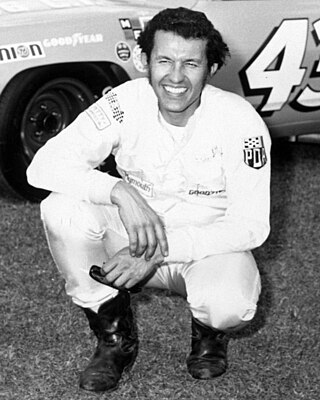
Darrell Lee Waltrip is an American motorsports analyst, author as well as a former national television broadcaster and stock car driver. He raced from 1972 to 2000 in the NASCAR Cup Series, most notably driving the No. 11 Chevrolet for Junior Johnson. Waltrip is a three-time Cup Series champion.
The 1976 NASCAR Grand National Winston Cup Series was the 28th season of professional stock car racing in the United States, the 5th modern era season of the Grand National series and sixth under R. J. Reynolds sponsorship through its Winston cigarette brand. The season began on Sunday, January 18 and ended on Sunday, November 21. Cale Yarborough, driving the #11 Junior Johnson Holly Farms Chevrolet scored his first of three consecutive NASCAR Grand National Series Winston Cup Championships. Skip Manning was named NASCAR Rookie of the Year.
The 1986 NASCAR Winston Cup Series was the 38th season of professional stock car racing in the United States and the 15th modern-era Cup series season. The season began on February 16 and ended November 16. Dale Earnhardt of RCR Enterprises won his second championship this year.

The 1974 NASCAR Winston Cup Series was the 26th season of professional stock car racing in the United States and the 3rd modern-era NASCAR Cup series. The season began on Sunday January 20 and ended on Sunday November 24. The first 15 races were shortened 10 percent due to the 1973 oil crisis. Following criticism of the 1972 and 1973 points systems that placed emphasis on completed miles, NASCAR implemented a new points system, that took basic purse winnings, multiplied by number of starts, and divided by 1,000; it was designed to more directly reward winning races, a response to Benny Parsons' championship the previous year with just one win. Richard Petty was Winston Cup champion at the end of the season finishing 567.45 points ahead of Cale Yarborough, while David Pearson finished a strong third in points despite only nineteen starts. Earl Ross was named NASCAR Rookie of the Year.

The 1979 Daytona 500, the 21st annual running of the event, was the second race of the 1979 NASCAR Winston Cup Series season. It was held on February 18, 1979 at Daytona International Speedway, in Daytona Beach, Florida. It has been called the most important race in stock car history.

The 1995 Daytona 500, the 37th running of the event, was held on February 19 at Daytona International Speedway in Daytona Beach, Florida. Dale Jarrett won his first career Winston Cup pole. Sterling Marlin won the race for the second straight year, his second Daytona 500 win, after leading 105 laps, including the final 20.
The 1977 NASCAR Grand National Winston Cup Series was the 29th season of professional stock car racing in the United States and the 6th modern era NASCAR Cup series. The season began on Sunday, January 16 and ended on Sunday, November 20. Cale Yarborough driving the Junior Johnson #11 Holly Farms Chevrolet won his second consecutive NASCAR Grand National Series Winston Cup Championship. Ricky Rudd was crowned NASCAR Rookie of the Year.

The 1984 Daytona 500, the 26th running of the event, was held February 19, 1984, at Daytona International Speedway in Daytona Beach, Florida. Cale Yarborough, who won the pole, completed a lap of 201.848 miles per hour (324.843 km/h), officially breaking the 200 miles per hour (320 km/h) barrier at Daytona. He won the race for the second year in a row, and the fourth time in his career, with an identical last-lap pass as the previous year, this time passing Darrell Waltrip who would later go on to win the same race in 1989.

The 1979 NASCAR Winston Cup Series was the 31st season of professional stock car racing in the United States and the 8th modern-era Cup series. It began on Sunday, January 14, and ended on Sunday, November 18. Richard Petty won his seventh and final Winston Cup championship, winning by 11 points over Darrell Waltrip. Dale Earnhardt was crowned NASCAR Rookie of the Year.

The 1969 Daytona 500 was a NASCAR Grand National Series race held on February 23, 1969, at Daytona International Speedway in Daytona Beach, Florida.

The 1971 Daytona 500, the 13th running of the event, was a NASCAR Winston Cup Series race held on February 14, 1971 at Daytona International Speedway in Daytona Beach, Florida. Spanning 500 miles (800 km) on the paved oval track, it was the first Daytona 500 in the Winston Cup era of NASCAR. During this time, Richard Petty was becoming one of the winningest veterans on the NASCAR circuit.

The 1972 NASCAR Winston Cup Series was the 24th season of professional stock car racing in the United States and the 1st modern-era NASCAR Cup series season. The season began on Sunday January 23 and ended on Sunday November 12. Richard Petty won his second consecutive Winston Cup Championship and fourth overall. Larry Smith was named NASCAR Rookie of the Year.
The 1973 NASCAR Winston Cup Series was the 25th season of professional stock car racing in the United States and the 2nd modern-era Cup season. The season began on Sunday January 21 and ended on Sunday October 21. 31 races were scheduled in the 1973 season. 28 were held.

The 1980 NASCAR Winston Cup Series was the 32nd season of professional stock car racing in the United States and the 9th modern-era NASCAR Cup season. It was the final year with the Gen 2 car. The season began on Sunday, January 13 and ended on Sunday, November 15. Dale Earnhardt won his first Winston Cup championship, winning by 19 points over Cale Yarborough. Jody Ridley was crowned NASCAR Rookie of the Year.
The 1978 NASCAR Grand National Winston Cup Series was the 30th season of professional stock car racing in the United States and the 7th modern era NASCAR Cup series. The season began on Sunday, January 22 and ended on Sunday, November 19. Cale Yarborough driving the Junior Johnson #11 First National City Travelers Checks Oldsmobile won his then record third consecutive NASCAR Grand National Winston Cup Winston Cup. Ronnie Thomas was crowned NASCAR Rookie of the Year in a tight battle with Roger Hamby.

The 1980 Talladega 500 was a NASCAR Winston Cup Series race that took place on August 3, 1980, at Alabama International Motor Speedway in Talladega, Alabama, USA.

The 1978 Talladega 500 was a NASCAR Winston Cup Series race that took place on August 6, 1978, at Alabama International Motor Speedway in Talladega, Alabama.

The 1979 Talladega 500 was a NASCAR Winston Cup Series race that took place on August 5, 1979, at Alabama International Motor Speedway in Talladega, Alabama.

The 1975 Winston 500 was an automobile race at the Alabama International Motor Speedway on May 4, 1975.

The 1977 Winston 500 was a NASCAR Winston Cup Series race that took place on May 1, 1977, at Alabama International Motor Speedway in Talladega, Alabama. The tenth of 30 races of the 1977 Winston Cup Grand National season, the Winston 500 started 41 cars.











